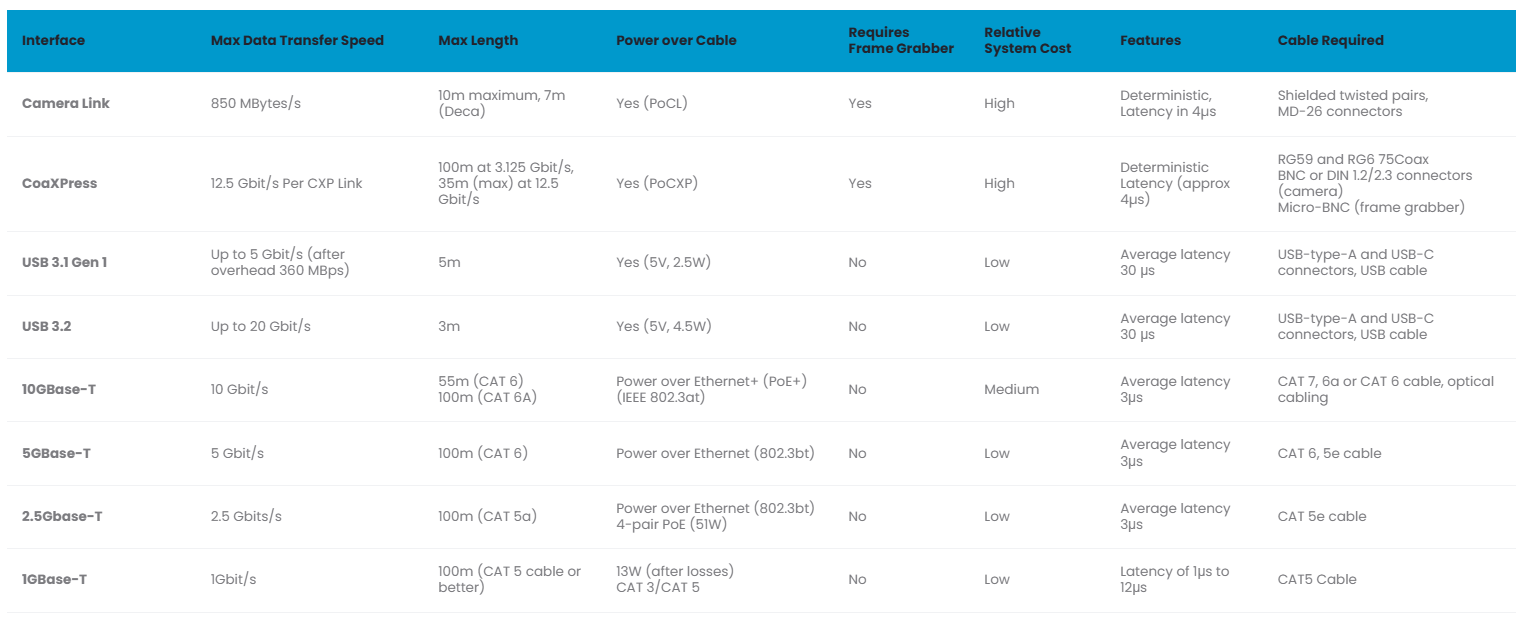
Understanding GigE Cameras: Interface, Advantages & Future Trends
In the world of machine vision, choosing the right camera interface can make or break the efficiency of an imaging system. Whether you’re building a quality inspection solution for a manufacturing line or developing a vision-based AI model, the type of camera you select and how it connects to your system is critical. One interface that continues to stand out for its balance of performance, flexibility, and cost-effectiveness is GigE. In this post, we’ll dive into what GigE cameras are, how they compare to other popular interfaces like USB, CoaXPress, and Camera Link, and why they’re a great option for the future of high-speed, high-resolution imaging.
What Are GigE Cameras?
GigE cameras are industrial cameras that use Gigabit Ethernet (GigE) technology to transmit image data. GigE is a well-established networking standard (IEEE 802.3) capable of transferring data at up to 1 gigabit per second (1 Gbps) over standard Ethernet cables (CAT5e or CAT6). Unlike USB or Camera Link, GigE allows cameras to transmit data over long distances, up to 100 meters without the need for signal boosters or repeaters.
These cameras are widely used in industrial automation, scientific research, medical imaging, manufacturing production lines, and defence & aerospace, where reliability, cable length, and resolution are key concerns.
GigE vs Other Interfaces
GigE vs USB Cameras

USB 3.0 is faster on paper, but GigE wins in real-world applications requiring long distances, robust networking, and scalable multi-camera setups.
GigE vs CoaXPress
CoaXPress (CXP) is a high-speed interface often used in demanding applications like flat-panel inspection or high-speed sorting. It offers higher bandwidths up to 25 Gbps per cable in CoaXPress 2.0.
However, CoaXPress requires specialized frame grabbers, more expensive cables and hardware, and more complex setups.
CoaXPress is ideal for ultra high-speed imaging, but GigE offers a more affordable, simpler alternative for the majority of use cases.
GigE vs Camera Link
Camera Link has been around for decades and is a staple in machine vision. It offers low latency and deterministic performance but comes with short cable lengths and requires frame grabbers.
Camera Link is great for tightly controlled environments. GigE is better suited for distributed systems and remote camera installations.
There are limited camera options available with CoaXPress and Camera Link interfaces, which confines their suitability to specific applications and use cases.
The Future of GigE: 5 GigE, 10 GigE, 25 GigE and Beyond
While 1 GigE has been the standard for years, the evolution of GigE cameras is already underway. With rising demands for higher resolutions and frame rates, newer versions like 5 GigE, 10 GigE and 25 Gig are hitting the market, offering significant bandwidth improvements while maintaining the Ethernet ecosystem’s key benefits such as standard cabling, long distances, and Power over Ethernet (PoE+).
These new variants enable applications like AI-based inspection, real-time 3D imaging, and high-speed motion capture, areas where traditional interfaces often fall short or get cost-prohibitive.

source: thinklucid.com
Why Choose GigE: Key Advantages
Long Cable Lengths
GigE supports up to 100 meters using standard Ethernet cables, making it perfect for large-scale industrial or remote camera installations.
Ideal for Multi-Camera Setups
Using multi-channel PCIe network interface cards, you can connect multiple GigE cameras to a single host. PCIe cards are more reliable for delivering maximum bandwidth, ensuring stable performance across all camera channels.
High Resolution & Frame Rates
With 5 GigE, 10 GigE, and beyond, GigE cameras can now support multi-megapixel sensors and fast frame rates, closing the gap with CoaXPress in many use cases. For example, a 65MP camera using 10 GigE can capture and transmit images at 14 frames per second, making it suitable for applications requiring both high resolution and respectable speed—such as detailed inspection, aerial imaging, or scientific analysis.
Cost-Effective Infrastructure
GigE eliminates the need for frame grabbers. You can use off-the-shelf networking hardware, which reduces the total cost of ownership.
Flexible Power Delivery
With Power over Ethernet (PoE) and PoE+, you can power cameras through the same cable used for data transfer, reducing clutter and simplifying installation.
Real-World Applications of GigE Cameras
Automated Optical Inspection (AOI)
GigE cameras are ideal for detecting defects or misalignments in electronics and automotive components. Their high resolution and long cable support make them easy to integrate into large production lines.
Robotic Vision
Used in smart factories and warehouses, GigE cameras provide real-time vision for robots performing tasks like sorting, picking, and navigating. Long cable runs and PoE simplify installation on robotic arms or mobile units.
Medical Diagnostics
In medical imaging devices like digital microscopes and scanners, GigE cameras capture detailed images of samples with minimal noise. They also fit well into hospital IT setups using standard network hardware.
Traffic Enforcement and License Plate Recognition
GigE cameras handle high-speed imaging for traffic systems, capturing clear images of fast-moving vehicles. They’re often used in red-light enforcement, speed monitoring, and ALPR systems.
Laboratory Research and Time-Lapse Imaging
Researchers use GigE for time-lapse studies and motion tracking. The ability to run long cables and connect multiple cameras to standard networks makes them ideal for lab setups.
Packaging and Pharmaceutical Inspection
GigE cameras help ensure label accuracy, fill levels, and seal integrity on high-speed packaging lines. Their scalability and resolution support strict quality control requirements.
Defence & Aerospace
GigE cameras are used in surveillance, target tracking, and airborne imaging systems where reliability and real-time data are critical. Their ability to transmit high-resolution images over long distances using standard Ethernet infrastructure makes them suitable for integration into aircraft, drones, and ground vehicles.
Conclusion
GigE cameras have stood the test of time by delivering a smart balance between performance, flexibility, and cost. As imaging requirements continue to grow driven by AI, automation, and smart manufacturing, high-speed variants like 5 GigE, 10 GigE, and 25 GigE are pushing the boundaries of what GigE can do.
For many applications, especially those requiring multi-camera setups, long cable runs, and high-resolution imaging, GigE remains a top choice and its future looks brighter than ever.
